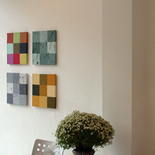
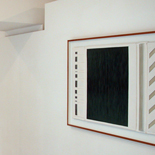
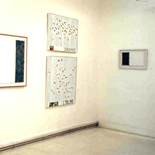
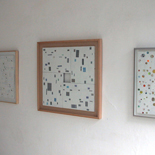
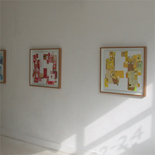
Review by Mary Ann Caws:
Writing, in April 2000, about Jonathan Meyer's work, Mark Cousins used the notions of signscape and then flightscape, from a bird's view of it. Agreeing with the imaginative movement from one to the other of those terms, and with Cousins' description of Meyer's collages as creating their own space, and "struggling into paint", I want to add my view now, from the summer of 2002, upon these and other of Meyer's works.
Among my favourite works are the tripartite Credit Slip, Stampede, Ground, and Equals, in the latter of which the shapes sneak through the two vertical division markers, giving a feeling at once of unease and freedom. It would be hard to overlook his Flag series, especially for those of us who are converts (or from-the-beginning-enthusiasts) to Barnett Newman's strongly divided and strongly hued constructions.
Among recalls of American painters, the Pack and Pack Trip forms are reminiscent of a few of Robert Motherwell's red and yellow forms in their single and triplet incarnations. In fact the notion of "recall" would seem crucial to Jonathan Meyer's way of dealing with his working-out of things -- for it at once refers and refuses enclosure in such reference. I am thinking here, in particular, of the Jet Set series, a recent quadripartite work, with its four panels each a different colour and cohesive in their singularity, where a light bulb in the black panel sends you instantly to one in the yellow panel, and perhaps, to Guernica's celebrated light bulb, although nothing is fixed or determined in its reference. This kind of loose illumination might stand as iconic of Meyer's work in general.
As for the genre of his recent work, there are actually two types of collage, the more traditional sort (Oyster, Stuck, Racket, the Pokemon series) and another more far-out sort, where various oddly-assorted elements (coins, staples, acupuncture needles, ball bearings, etc.) have been cast flat, suspended in acrylic medium, or, dissected pieces of a larger element (such diverse materials as copper, aluminium, rubber and plastic, in the case of Cable) are affixed to a support, over which liquid medium and ultimately paint is applied.
In these latter collages a further process fixes the ambiguous relationship between the cast elements and the medium they are suspended in, as the drying acrylic catalyses a green patination of the copper content (as in the earlier Flag series). Something about the unevenness of such pieces lends both surprise and character to them. That we don't know exactly where we are fits, however disturbingly, the temper of our times, whereas the semiotic references grow all the more complex in our minds. One thing is sure, whatever the temper of viewer or artist, the more openly abundant the ways of experiencing all the various shapes, forms, and feelings offered, the more they can shape, form and feel the articulations in the different pieces of work.
Mary Ann Caws (New York, 2002)